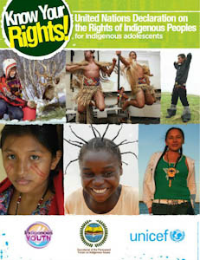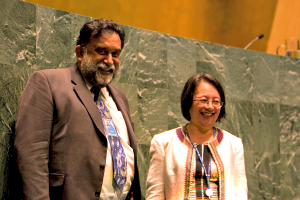United Nations Declaration on the Rights of Indigenous Peoples (A/RES/61/295) – Official UN languages
English | Español | Français | Русский | عربي | 汉语 (PDF version)
English | Français | Español | Русский | عربي | 汉语 (Official Resolution Text)
Adolescent friendly version
 Know your Rights:
Know your Rights:
Adolescent friendly version of the Declaration on the Rights of Indigenous Peoples
English
Conoce tus Derechos:
Declaración de la ONU sobre los Derechos de los Pueblos Indígenas para adolescentes
Español
Декларация Организации Объединенных Наций о правах коренных народов:для детей подросткового возраста из числа коренных народов
Русский
Other languages
Note that these are unofficial translations provided to the Secretariat of the United Nations Permanent Forum on Indigenous Issues. The terminologies used in the translations do not necessarily reflect that of the United Nations.
Arawok (spoken in Surname) – provided by UNDP Suriname
Aucan (spoken in Surname) – provided by UNDP Suriname
Aymara – provided by COINCABOL
Bahasa/Indonesian – provided by West Papua Interest Association
Belarusian
Bisaya (spoken in the Philippines) – provided by Tebtebba
Bodo (Boro) Spoken in India – provided by Indian Confederation of Indigenous and Tribal Peoples North East Zone
Carib (spoken in Surname) – provided by UNDP Suriname
Cha’palaa (spoken in Equador) – provided by UNICEF, Latin America and the Caribbean Regional Office
Catalan – provided by alterNativa Intercanvi amb Pobles Indígenes
Crimean Tatar, provided by the Foundation of Research and Support of Indigenous Peoples of Crimea
Degar (spoken in Vietnam) povided by the Montagnard Foundation.
Dutch, provided by the Netherlands Center for Indigenous Peoples
Danish – provided by the Greenland Home Rule Government
Finnish– provided by the Government of Finland
German – provided by the German Translation Section of the United Nations
Greek – provided by UNRIC Brussels
Greenlandic – provided by the Greenland Home Rule Government
Guaraní – provided by the United Nations Development Programme (UNDP), Paraguay
Hindi – provided by UNIC, India
Ilokano (spoken in the Philippines) – provided by Tebtebba
Innu (spoken in Innu-aimun) – provided by Innu Council of Nitassinan/Institut Tshakapesh
Italian – provided by the University of Torino
Japanese
Karaim – provided by UNIC, Warsaw
Karelian (Karjala)–a Finno-Ugric language spoken mainly in the Republic of Karelia (Russian Federation) and partly in Finland–unofficial translation
Khmer – provided by RIPP/UNDP
Kichua (spoken in the Andes) – provided by UNICEF, Latin America and the Caribbean Regional Office
Kituba – provided by UNIC, Congo
Kuna – (spoken in Panama)
Kwéyòl (spoken in Saint Lucia)
Komi (Komi kyv)–a Finno-Ugric language spoken by the Komi people in the northeastern European part of Russia–unofficial tranlsation
Lingala – provided by UNIC, Congo
Livvi-Karelian (Livvi)–a Finno-Ugric language spoken mainly in the Republic of Karelia (Russian Federation) and partly in Finland–unofficial translation
Malay – provided by RIPP/UNDP
Maori (spoken in New Zealand)
Maya – (spoken in Central America)
Mapuche – provided by UNIC, Argentina
Miskito (spoken in Nicaragua and Honduras)
Mohawk (spoken in North America)
Náhuatl (spoken in Mexico)
Nanai (spoken in Russia–Provided by Sakhalin Energy)
Norwegian – provided by the Government of Norway
Nepali – provided by Nepal Federation of Indigenous Nationalities
Persian – provided by UNIC, Tehran
Pilipino – provided by Tebtebba Foundation, Philippines
Polish – provided by UNIC, Warsaw
Portugues – provided by UN Information Centre, Rio de Janeiro, Brazil
Sámi (North) – provided by Finnish Sámi Parliament
Sámi (Inari) – provided by Finnish Sámi Parliament
Sámi (Skolt)– provided by Finnish Sámi Parliament
Thai – provided by RIPP/UNDP
Trio (spoken in Suriname) – provided by UNDP Suriname
Turkish – provided by UNIC, Turkey
Uilta – (spoken in the Russian Federation) – provided by Sakhalin Energy
Ukrainian – provided by Ukrainian Institute of legislation
Veps (Vepsä)–a Finno-Ugric language spoken by the Vepsians in the Republic of Karelia, Leningrad and Vologda regions of the Russian Federation–unofficial tranlsation
Wajana (spoken in Suriname) – provided by UNDP Suriname
Wichi – provided by UNIC, Argentina
 The United Nations Declaration on the Rights of Indigenous Peoples (UNDRIP) was adopted by the General Assembly on Thursday, 13 September 2007, by a majority of 143 states in favour, 4 votes against (Australia, Canada, New Zealand and the United States) and 11 abstentions (Azerbaijan, Bangladesh, Bhutan, Burundi, Colombia, Georgia, Kenya, Nigeria, Russian Federation, Samoa and Ukraine).Click here to view the voting record.
The United Nations Declaration on the Rights of Indigenous Peoples (UNDRIP) was adopted by the General Assembly on Thursday, 13 September 2007, by a majority of 143 states in favour, 4 votes against (Australia, Canada, New Zealand and the United States) and 11 abstentions (Azerbaijan, Bangladesh, Bhutan, Burundi, Colombia, Georgia, Kenya, Nigeria, Russian Federation, Samoa and Ukraine).Click here to view the voting record. Welcome to the United Nations
Welcome to the United Nations
